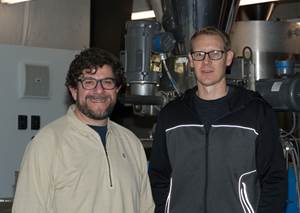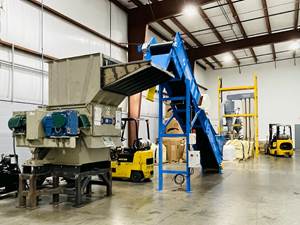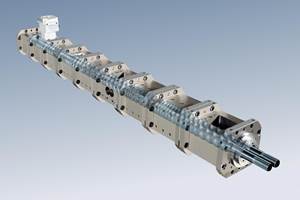K 2010 Preview, Compounding ‘Slower’ Compounders Suggest Trend Toward Energy-Efficient Designs
channel depth in larger machines, which exposes the material to less mechanical stress at comparable residence times.
channel depth in larger machines, which exposes the material to less mechanical stress at comparable residence times. Moreover, the combination of medium speeds and increased channel depths are said to substantially reduce screw and barrel wear. The company has optimized the extruder power train and heating system to further increase energy efficiency.
KM Berstorff also will introduce the EasyClean compounding line designed to reduce cleaning and changeover times by up to 40%. The design features clamp joints and clamped flange connections at the feed hoppers and the material conduits to the metering devices and the silos that can be loosened without tools.
The docking station for the bulk-solids metering device was also engineered to speed up product changeovers: During a change, the second metering device can be cleaned off-line.
The line at the show will be a ZZE 60-mm twin-screw equipped with a Mixomat—a device that combines conveying, weighing, and mixing functions in a single unit. This cost-effective system reduces the number of metering devices required for frequent compound changes involving different pellet types. A large cleaning opening allows quick cleanout when material or color is changed.
The Mini-Compounder KETSE 12/36, from Brabender (cwbrabender.com) is a 12-mm, 36:1 L/D twin-screw machine for product development and lab applications. The clamshell barrel opens to allow visual assessment of individual processing steps. Metering and venting ports can be located at 0 D, 6 D, 12 D and 26 D. Side feeding can be installed at 14 D. Brabender also offers this machine in a 20-mm, 40:1 L/D configuration.
HIGH-OUTPUT PELLETIZING
For high-capacity polyolefin production, Coperion (coperion.com) will display the UG 1.250, said to be the largest underwater pelletizer in the world. It enables throughputs in excess of 100 tons/hr for polyethylene. The first UG 1.250 will go into operation soon. A slightly smaller but similarly constructed UG 925 for polypropylene has been in operation since the middle of 2009.
Coperion is also offering an exceptionally large underwater pelletizer for TPE. The UG 750, which will be installed at the beginning of 2011, was designed to account for the stickiness typical of TPE pellets. Axial water flow along the knife shaft into the cutting chamber, and radial water flow along the pelletizing knives towards the water chamber exit, minimize turbulence in the cutting chamber. This results in fewer collisions between the freshly cut, tacky pellets, which prevents agglomeration.
Coperion will be introducing a new size melt pump. Model MP 450 can handle 30 to 50 tons/hr of PP and 40 to 50 tons/hr of PE. The pumps have single or twin shaft drive options.
Gala Industries (gala-industries.com) will show introduce its Model EAC (Electronically Adjusted) pelletizer for production rates up to 33,000 lb/hr. The pelletizer offers fully automated control of blade adjustment and positioning for maximum blade and die life. Monitoring and adjustment are programmed in the PLC controller. An integrated blade-position measuring system alerts the operator when a blade change is needed.Not too long ago, high-speed, high-torque twin-screw compounders were all the rage. They operated at blazing speeds up to 1800 rpm and required high drive power. At K 2010, KraussMaffei Berstorff (berstorff.com) is dialing back a bit, presenting a ZE 60 A UTX twin-screw with max. speed of 600 rpm and design features that enhance energy efficiency. KM Berstorff has conducted tests revealing that substantial energy savings and quality enhancements can be achieved in many applications if larger extruders are operated at medium speeds instead of using smaller machines at high speeds.
Related Content
More Than a Compounder: They Have the Science to Create New Custom Materials
Insight Polymers & Compounders leverages its expertise in polymer chemistry to develop next-generation materials.
Read MoreSirmax Adapts Integrated Recycling Approach to US Supply Conditions
Integrating compounding and recycling to leverage untapped postindustrial recycling feedstocks.
Read MoreEngineering Resins Compounder Expands to Take on More Scrap
Polymer Resources responds to sustainability push by upgrading plant with grinding and shredding equipment to take on both postindustrial and postconsumer reclaim.
Read MoreHow to Configure Your Twin-Screw Barrel Layout
In twin-screw compounding, most engineers recognize the benefits of being able to configure screw elements. Here’s what you need to know about sequencing barrel sections.
Read MoreRead Next
Making the Circular Economy a Reality
Driven by brand owner demands and new worldwide legislation, the entire supply chain is working toward the shift to circularity, with some evidence the circular economy has already begun.
Read MorePeople 4.0 – How to Get Buy-In from Your Staff for Industry 4.0 Systems
Implementing a production monitoring system as the foundation of a ‘smart factory’ is about integrating people with new technology as much as it is about integrating machines and computers. Here are tips from a company that has gone through the process.
Read MoreSee Recyclers Close the Loop on Trade Show Production Scrap at NPE2024
A collaboration between show organizer PLASTICS, recycler CPR and size reduction experts WEIMA and Conair recovered and recycled all production scrap at NPE2024.
Read More






















